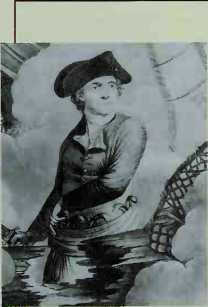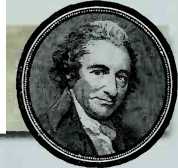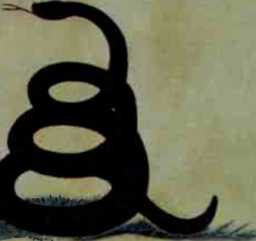On May 31, 1779, British forces captured Stony Point, New York, but Americans under General "Mad Anthony" Wayne retook it, reestablishing control of the Hudson River. Washington's forces continued to blockade New York City, but it would be a long time before the Americans would see another victory.
Stalemate and Starvation. In the northern
Colonies during 1779 and 1780, the Revolution had reached a stalemate. Many believed it was worse than that; they thought that the war was all but lost.
The fighting with Britain had gone on now for four years. The American economy was shattered—the Continental dollar worth almost nothing. Fields and barns across the counti-y had been picked clean to feed the army. The country’s resources were evaporating, and the spirit of the Revolution was disappearing with them. At the same time, war profiteers who took advantage of shortages were rampant.
Bitter soldiers, away fi'om home, worried about the survival of their wives and children. One woman wrote to her husband; "I am without bread and cannot get any. My children will starve or, if they do not, they must freeze."
Anguished by such pleas and without food themselves, many men deserted. From winter 1779 through 1781, Washington found himself putting down mutiny after mutiny.
The weather didn’t help. As the Continental Army wintered at Morristown, New Jersey, in 1779, it found itself in the midst of the worst winter in memory. Drifts as high as eight feet suiTounded the huts of shivering and desperate men, who could not even count on food to eat. "We were absolutely, literally starved,” wrote one young soldier.
Siege of Charleston. The Revolution still burned,
Though the real fighting had now switched to the South. By 1779, all of Georgia had fallen to the British. The next year a combined French and American effort failed to dislodge them. The British now had their eye on the important city of Charleston, South Carolina.
General Henry Clinton was encouraged by the English success in Georgia. In 1780, he and Lord Charles Cornwallis sailed south with an 8,500-man army. They landed in Charleston in February and spent the next few months adding to their army until it was 10,000 strong.
The British army in Charleston was now twice the size of the Continental army there, and the Patriots were quickly wiped out. After the surrender of Charleston, the British seized as much of the South as possible, raiding and burning towns along the way.
Disgrace and Defeat, in August nso, at camden.
South Carolina, Cornwallis dealt the Americans another crushing defeat. Most of the Patriot soldiers were

THE BONHOMME RICHARD
One of the worst problems the Americans had was their iack of a navy. Without one, they were at the mercy of the powerful British Navy, and the French were as yet unwilling to use their ships in the Patriot cause. The American navy remained more illusion than reality, although it did claim one intrepid captain. Scottish-born John Paul Jones had fled to America from England to avoid prosecution for killing a mutinous sailor. Commissioned by Washington, Jones conducted several raids on British shipping during 1778.
In September of 1779, the Scotsman immortalized himself when his Bonhomme Richard met the British ship Serap/s off the English coast.
Moments after the battle began, one of the Bonhomme’s cannons exploded, maiming many of her crew. The British called on the American captain to surrender. But Jones was undaunted. He lashed his crippled ship to the Serap/s and continued fighting at close range until the Serap/s, too, was about to collapse.
The British crew, astonished at Jones’ crazed struggle, were too frightened even to try to haul down the British flag in surrender. Serap/s’own captain was forced to pull down her colors. The Bonhomme Richard sank three days later, and Jones sailed off victorious on the captured British vessel.


Dont tread on me
"Don’t Tread on Me" iiws one of the first American flags. Its message clear: Inteifere with our liberty at your peril.
Sick and half-starved when they met the well-fed British forces in the middle of the night. When the redcoats charged with bayonets, four fifths of the American army fled from the field. Worse, their commander, Horatio Gates, ran with them, spurring his horse fi'om the scene and riding all the way out of the state.
Gates’ disgraceful behavior was paid for in blood by an astonishingly brave group of Maryland and Delaware soldiers. Led by a Bavarian volunteer, Johann DeKalb, these 600 men stood their ground until Cornwallis threw his entire
Force, more than 6,000 men, against them. DeKalb himself, leading from the front, was wounded three times and finally bayoneted to death. The broken remnants of his command fled the field to avoid capture.
Southern Partisans. The Americans had lost two
Armies, but the dismal defeats at Charleston and Camden did not end the fighting in the South. Instead a strong guerrilla army rose up to harass the British.
“These are the times that try men's souls.”
—Thomas Paine
As the British moved farther inland, these private American armies repeatedly attacked British supply lines to the coast. Small bands would strike the British suddenly and then ride off before they could be captured. While bleeding the king’s forces, they also battled the many Loyalists and former Patriots who had joined the British cause.
One guerrilla force under Francis Marion was an especially sharp thorn in the British side. Lord Cornwallis was so incensed by this Swamp Fo.’s constant attacks that he sent out his crack officer, Banastre Tarleton, to catch Marion. Tarleton, who had a reputation for being unstoppable, dogged Marion but could not chase him down. "The devil himself could not catch him,” he complained.
Civil War. After the Declaration of Independence, it became an act of treason to take a pro-British stance. As many as 80,000 citizens left the colonies, half of them going to Canada. In the South, though, many Loyalists stood their ground. When the war came to these colonies, the fighting between Loyalists and Patriots created scenes of "devastation, bloodshed, and deliberate murder.” Houses and fields were burned and their owners’ throats cut.
Retaliations had reached a fevered pitch by early October 1780. The climax came when an American force of 1,400 frontiersmen, mountainmen, and guerrillas encircled 1,100 British Loyalists at Kings Mountain in South Carolina. This battle—pitting Americans against Americans—revealed clearly that the Revolution had become a civil war as much as a stmggle for independence. After the violent confrontation on Kings Mountain, American Loyalists lay in heaps. More than 150 were killed outright and 600 were captured. The gruesome battle finally turned back the pro-British tide. The victoiw also brought new recraits into the American ranks and warned other Southerners against joining the Loyalist side.




 World History
World History









